SOLD
Mid 20th Century Vintage Indigo Dyed Pure French Linen Villette Fabric Made Chore Work Worker Coat
今なお世界のリネン原料のフラックス(亜麻)生産の70%以上を生み出し続けるフランスは、文字通りのリネンの国です。温帯から熱帯の気候を必要とする綿の栽培が難しいフランスで、栽培が可能な亜麻は、衣類のみならずシーツなどの寝具や寝間着などのホームリネンから、テーブルクロスやナプキンなどのテーブルリネンにも使われフランス人にとっては綿以上に生活に密着した最も身近な繊維です。
France, which still produces more than 70% of the world’s flax, is literally the land of linen. Flax is used not only for clothing, but also for home linens such as sheets and bedding, table linens such as tablecloths and napkins, and is the most familiar fiber to the French, more closely related to their daily lives than cotton.
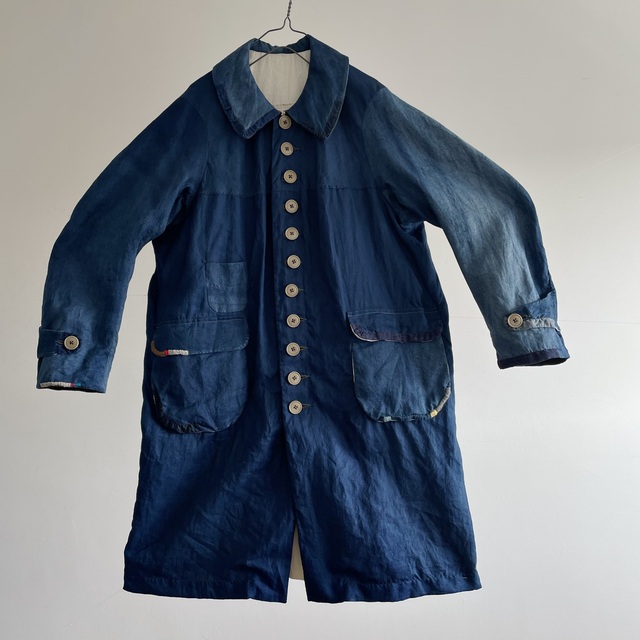
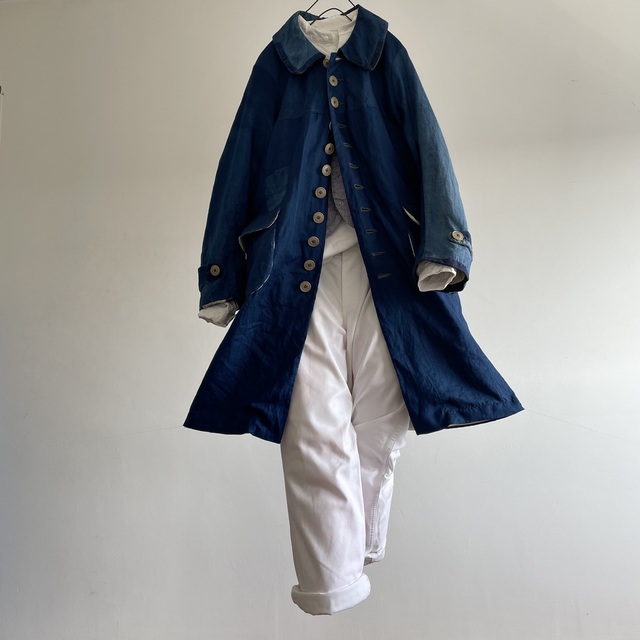
近年では中国などの紡績技術の発展により、原料栽培以外の工程(特に潤紡よる紡糸はほとんど中国)はフランス以外で行われ、リネンを糸にする紡績工程は国外がほとんどとなりました。しかし、この生地が作られた頃は、フランス国内で栽培、紡績、製織された真正のフレンチリネンと言える生地が作られていました。
In recent years, with the development of spinning technology in China and other countries, most of the processes other than the cultivation of raw materials (especially spinning by Junbun, which is mostly done in China) are now done outside of France, and the spinning process to turn linen into yarn is mostly done outside of France. However, at the time this fabric was produced, the fabric was grown, spun, and woven in France, and could be called a genuine French linen.

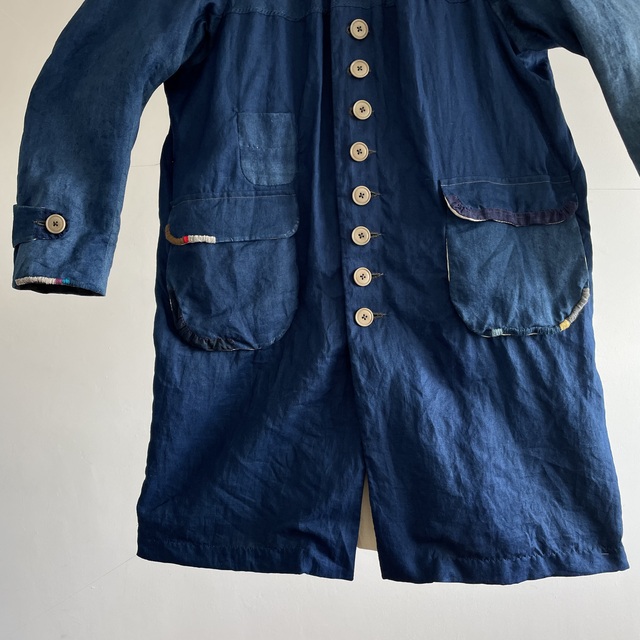
Maquignonの衣服に良く使われていた、細いリネン糸で織った生地をインディゴで染めたvilletteと呼ばれる生地。その中でも、この生地は、かなり軽く柔らかい風合いのもの。
A fabric called villette, often used in Maquignon garments, is woven with fine linen yarns and dyed with indigo. Among these fabrics, this one is quite light and soft in texture.
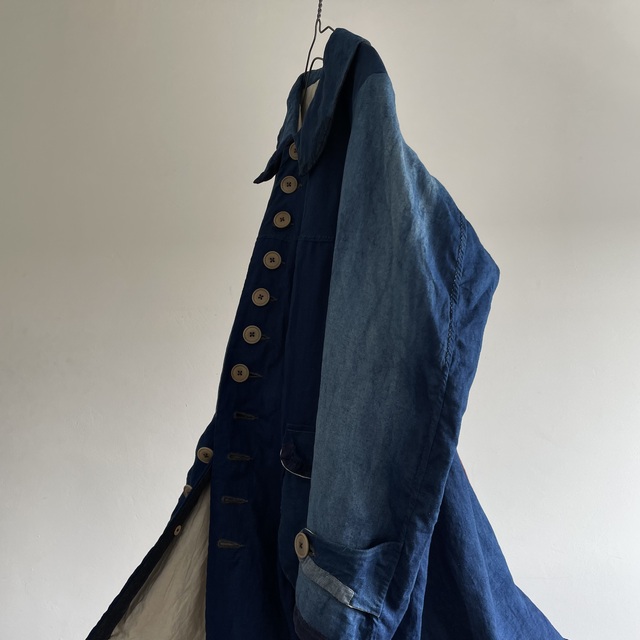
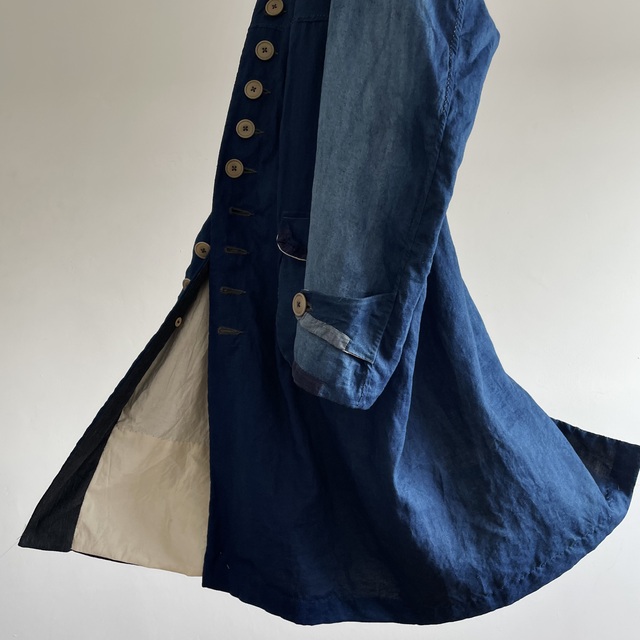
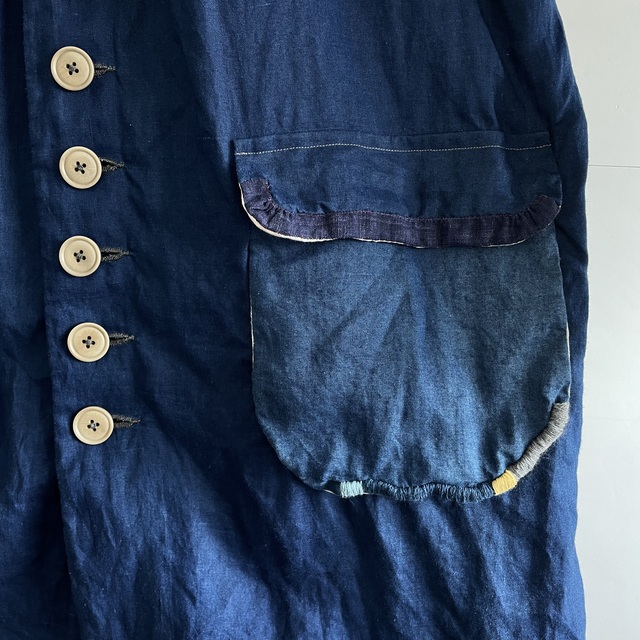
フランスの農村部などで作られた古い仕事着には、一般的にイメージされるフレンチワークウェアとは別の魅力が溢れています。
Old work clothes made in rural areas of France and other regions are full of a different kind of charm from the French work wear generally associated with them.
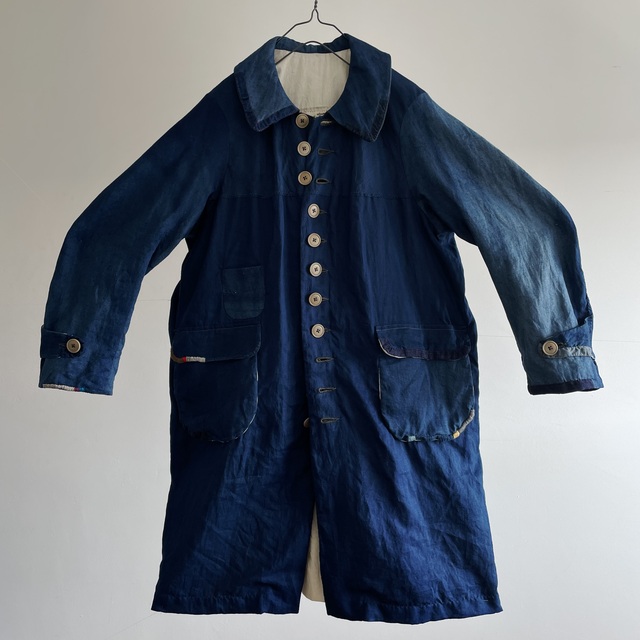
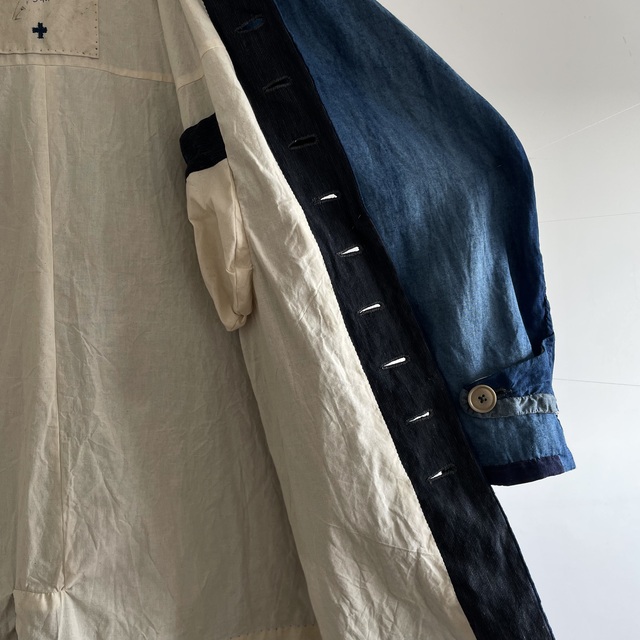
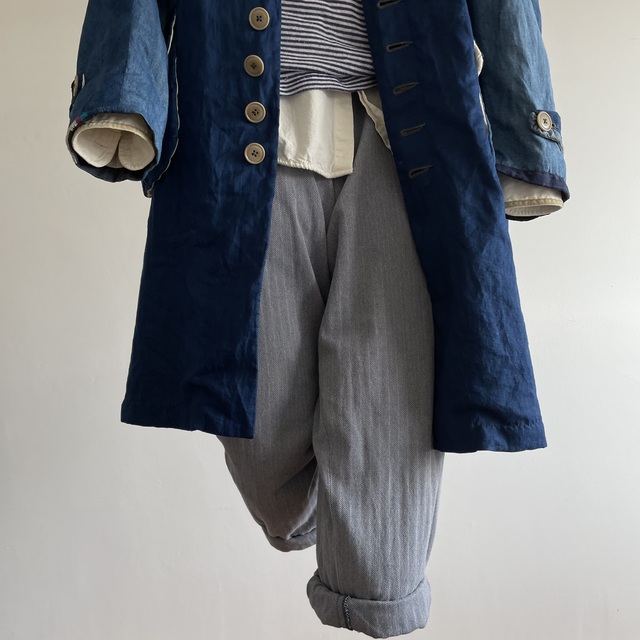
19世紀末頃から、都市部とその近郊地域での産業や商業の発展とともに発達し、産業革命や近代化の結晶としてのワークウェアは、服飾知識と技術を持った専門家によるデザインとパターン製作や、縫製や工程の管理を基本とした、ワークウェア自体が立派な商品となる工業生産品でした。
特にフランスのものは、テーラーワークを基本にしたパターンと縫製が作り出す立体的で曲線的なデザインと、雰囲気溢れる表情が今でも独特の魅力を持っています。
Workwear, which developed with the development of industry and commerce in urban and suburban areas from around the end of the 19th century, was the fruit of the Industrial Revolution and modernization, and was an industrial product that became a respectable commodity in itself, based on design and pattern making by experts with clothing knowledge and skills, and sewing and process control. The workwear itself was an industrial product that became a respectable commodity.
In particular, French items still have a unique charm with their three-dimensional, curvilinear designs and atmospheric expressions created by patterns and sewing based on tailor work.
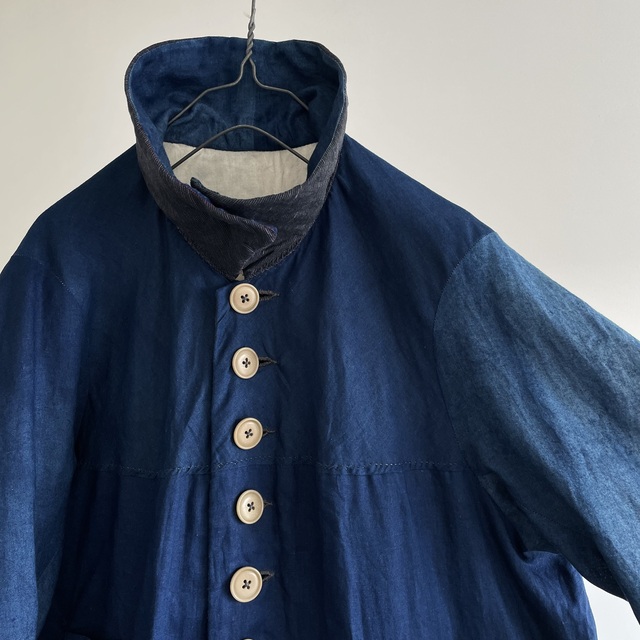
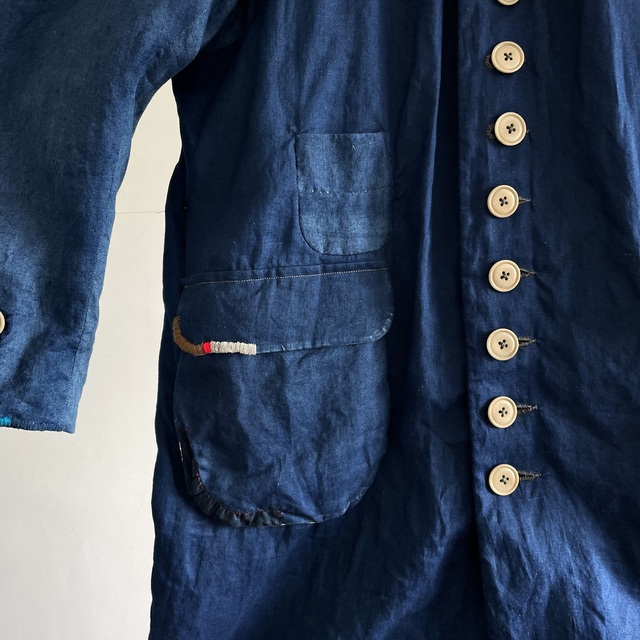
一方、周辺の農村部などでは、生活や仕事着が近代化されるのは1900年代の中期以降でした。今も食糧自給率が120%を超え、欧州連合(EU)一の農業生産国のフランスには、民族衣装から発展し、牧畜に従事する人々が作り上げたBiaudeや、農家の室内着や寝間着になったスモックなど豊かな感性に彩られたフランス独自の様々な衣料や仕事着が自らの手や町の仕立て屋で手作りされていました。
In the surrounding rural areas, on the other hand, it was not until the mid-1900s that people began to modernize their lifestyles and work clothes. France, which is the largest agricultural producer in the European Union (EU) with a food self-sufficiency rate of more than 120%, had developed from national dress, and various types of clothing and work clothes unique to France, such as biaude made by people engaged in cattle raising and smocks that became indoor wear and nightwear for farmers, were handmade by the people themselves or by tailors in the towns. The clothes were handmade by the people themselves or by tailors in the towns.
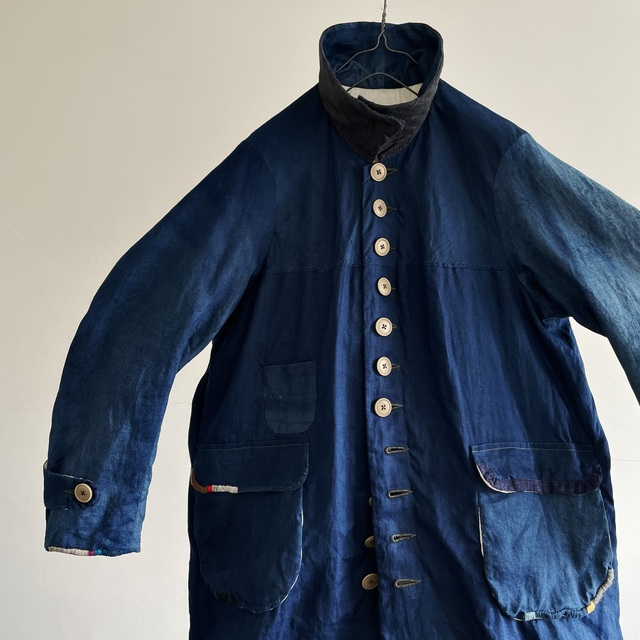
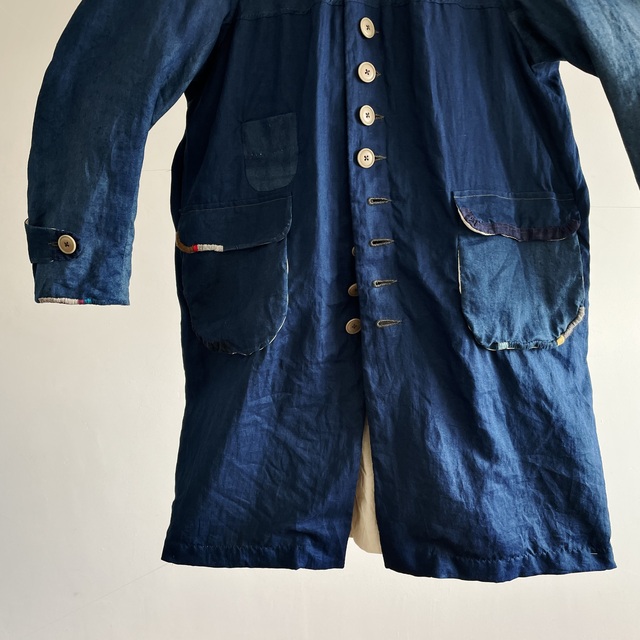
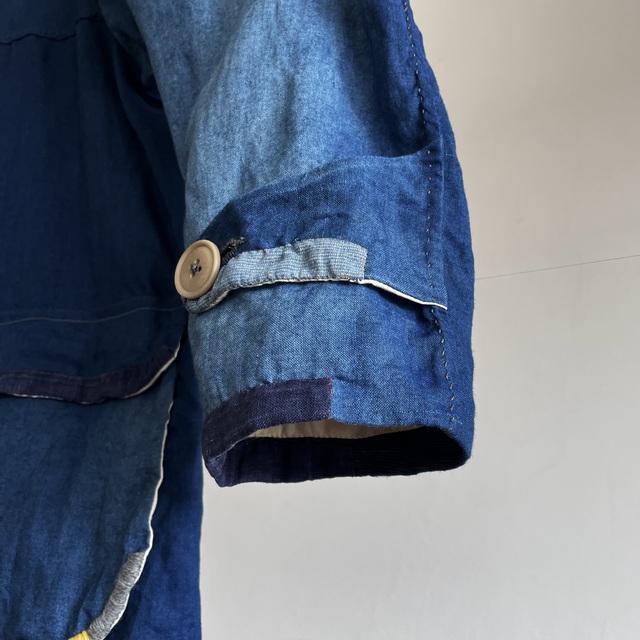
フランスのスモックやBiaudeは、出来上がった物を購入するだけではなく、農家の奥さんなどが、昔から受け継がれてきた物を見本に作り続けて来たものも多くあります。体に沿う立体的な形にするためのパターンなどの、服飾に対する専門的な知識が発達する以前から引き継がれてきた原型は、生地をできるだけ無駄なく使い、縫製も容易な直線で構成されたパーツを組み合わせた、ユニークな仕様で作られています。
French smocks and biaudes are not only purchased as finished products, but many have been made by farmer’s wives and others who have continued to make them based on samples passed down from generation to generation. The prototypes, which have been handed down from before the development of specialized knowledge about clothing, such as patterns for making three-dimensional shapes that conform to the body, are made to unique specifications, using as little fabric as possible and combining parts made of straight lines that are easy to sew.
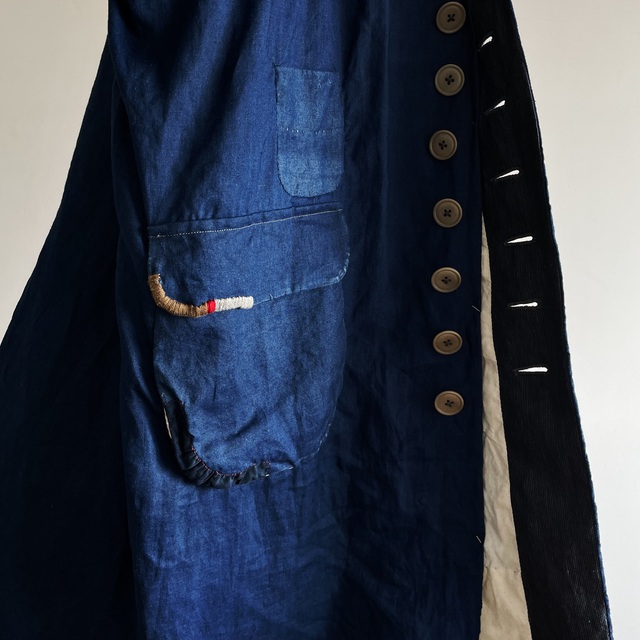
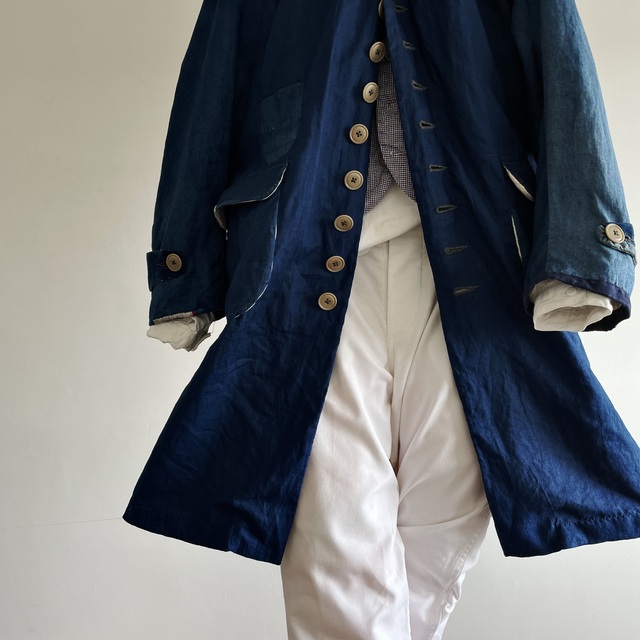
このコートの原型となったコートは、19世紀末から20世紀初頭の頃のもの。直線の四角形のパーツで構成されていて、その直線の組み合わせに施したギャザーでボリュームと運動量を確保した農家手作りのスモックなどのワークウェアから、テーラーの流れを取り入れた工業製品でありプロフェッショナルメイクのワークウェアへ移り変わる過渡期を暗示するようなユニークな組み合わせで仕立てられています。
The prototype of this coat dates from the end of the 19th century to the beginning of the 20th century. It is composed of straight rectangular parts, and the gathers applied to the combination of straight lines ensure volume and mobility, suggesting a transitional period from farmer’s handmade smocks and other workwear to industrial and professionally made workwear that incorporated the tailor’s trend. The unique combination is tailored.
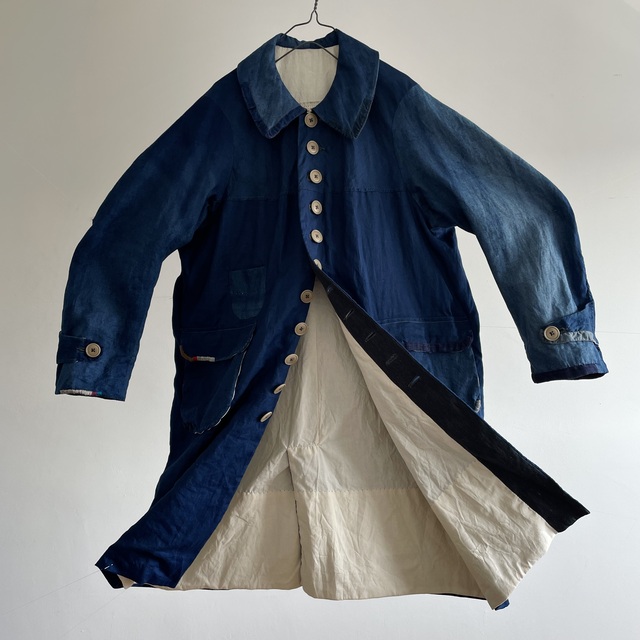
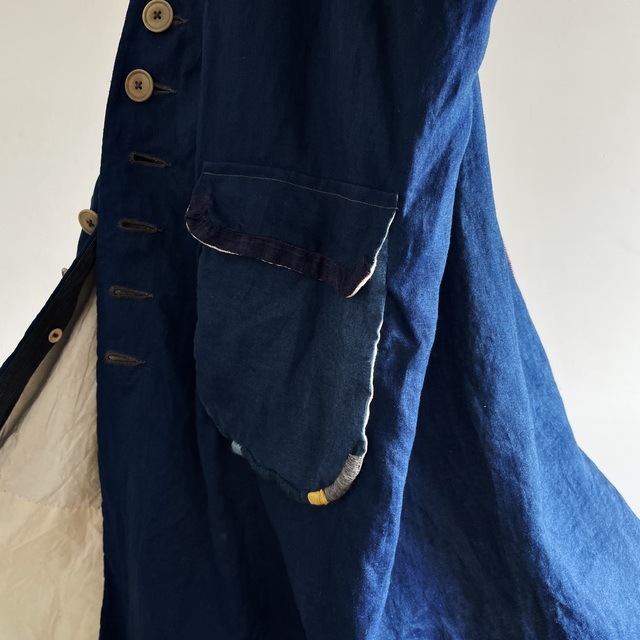
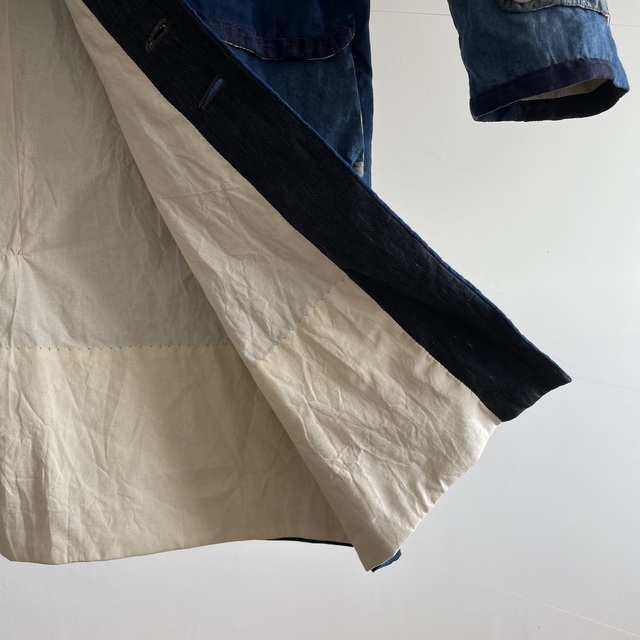
肩とヨーク部分のパーツが接ぎの無い1枚仕立ての特殊な仕様の、とても珍しい造りで作られたコート。背中の接ぎを経地に合わせたヨークのパーツが、体に沿って前に回り込んでくるにつれて、しだいに生地方向が変化し、肩から胸にかけてがバイアス方向の生地使いとなり、肩の傾斜に馴染むとともに、腕の動きにも沿う伸縮性を持った、とても理にかなった作りです。
This coat has a very unusual construction, with the shoulder and yoke parts made of a single piece of fabric without any joints. The yoke part, which is joined at the back to the fabric, gradually changes direction as it goes around the front along the body, and the fabric is used on the bias from the shoulders to the chest, making it a very logical construction that conforms to the slope of the shoulders and also has elasticity that follows the movement of the arms.
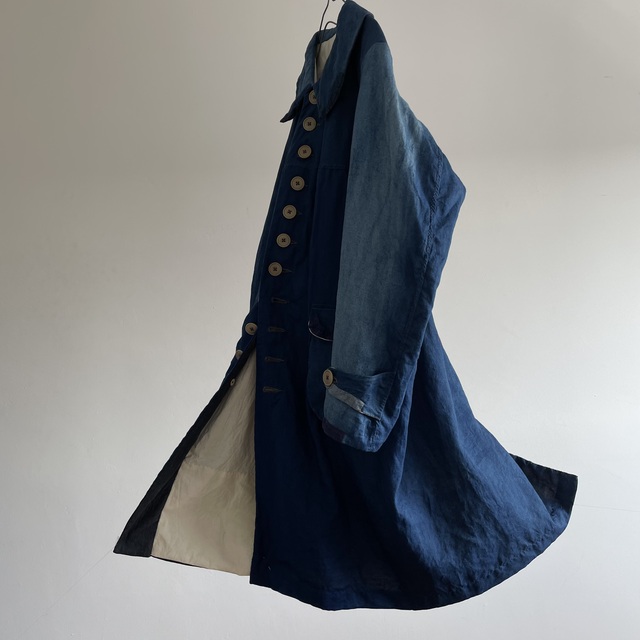
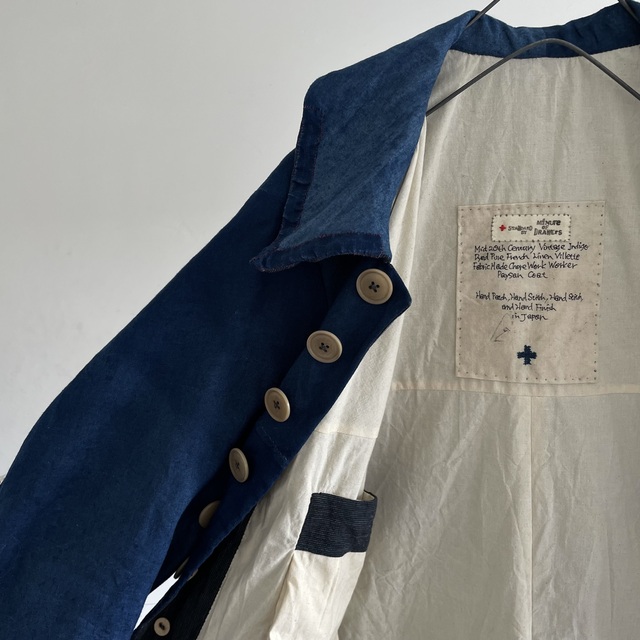
ナチュラルな肩のフォルムを作り出し、広い身幅と肩をバランスよく繋ぐパターンはフランスならではの発想だと思います。
The pattern that creates a natural shoulder form and connects the wide body width and shoulders in a well-balanced way is a uniquely French idea.
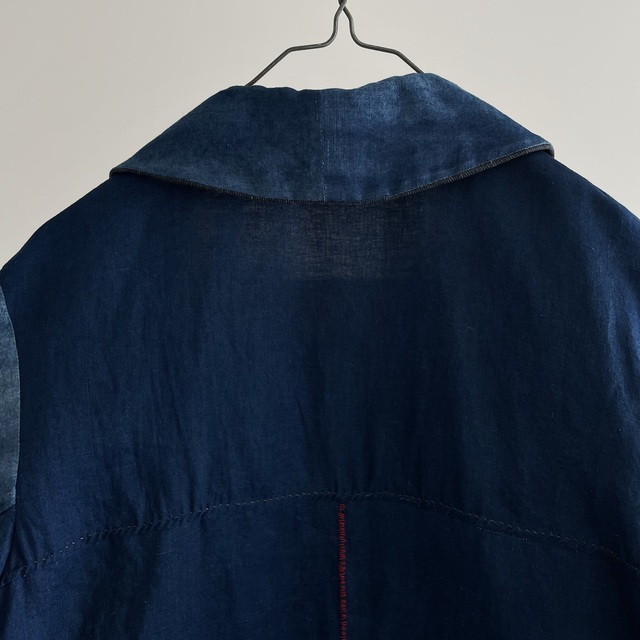
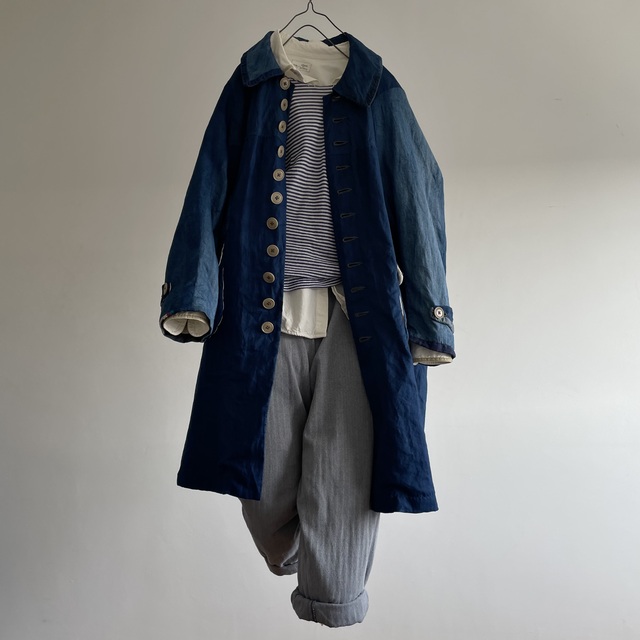
胸から下の身頃も、前身頃から背中の中心までを1枚で作り背中で繋いだたとてもユニークな設計。脇に接ぎがなくたっぷりとした身幅から裾に向かって緩やかに広がるシルエットは、比較的コンパクトな肩とのバランスの対比がユニークな味わいを深めてくれます。
The body from the chest down is also uniquely designed, made in one piece from the front to the center of the back and connected at the back. The silhouette gently widens from the generous body width to the hem without any side joins, and the contrast between the relatively compact shoulders and the balance of the body deepens the unique flavor of the garment.
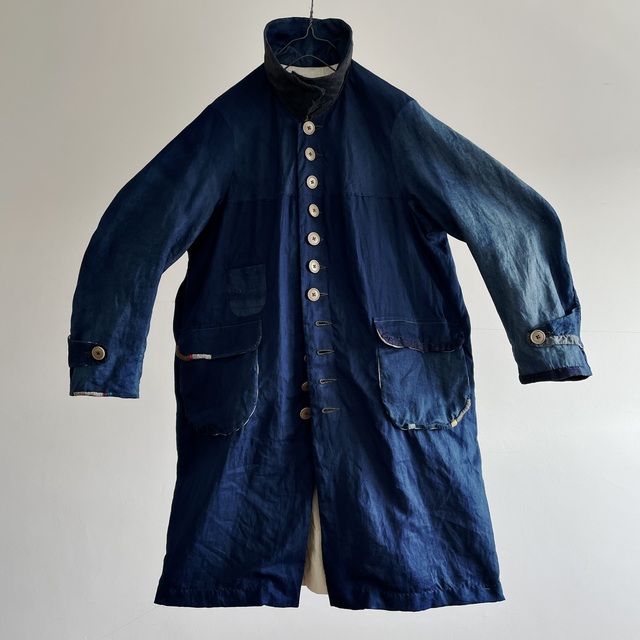
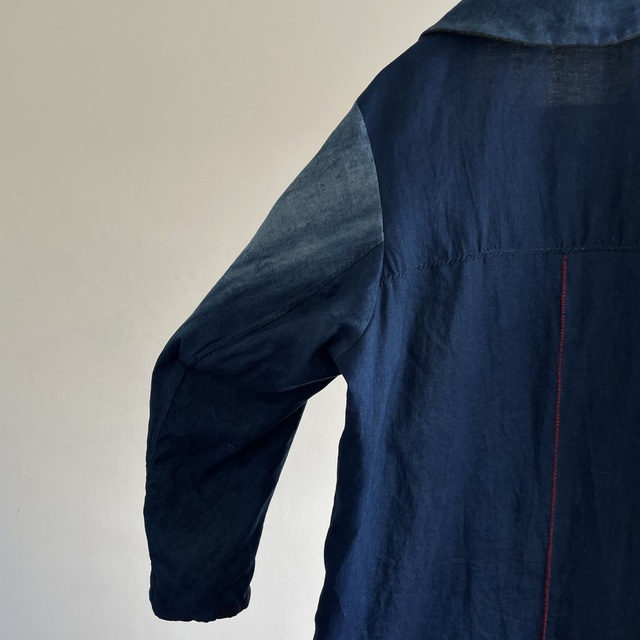
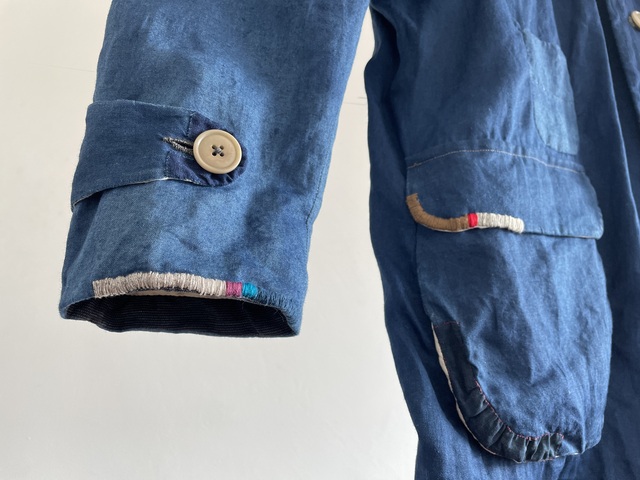
ユニークで立体的な発想の肩ヨークに、生地の横幅をそのまま利用して無駄なく生地を使って、繋ぎ合わせただけのまっすぐな身頃を合わせた面白い仕立て。ここに腕に沿った曲線を描く2枚袖の腕と、特徴的なフラットな衿といった組み合わせ。
The unique and three-dimensional conception of the shoulder yoke is combined with an interesting tailoring that uses the width of the fabric as it is without wasting any fabric, and with a straight body that is just joined together. The two-piece sleeves that curve along the arms and the characteristic flat collar are combined here.

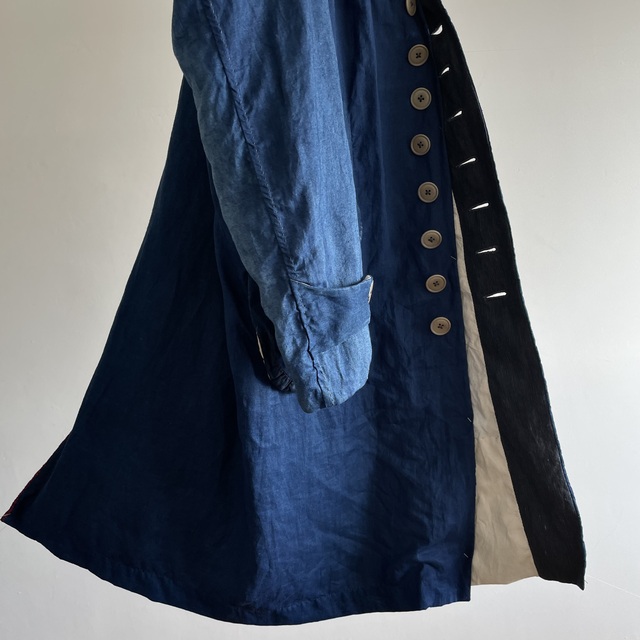
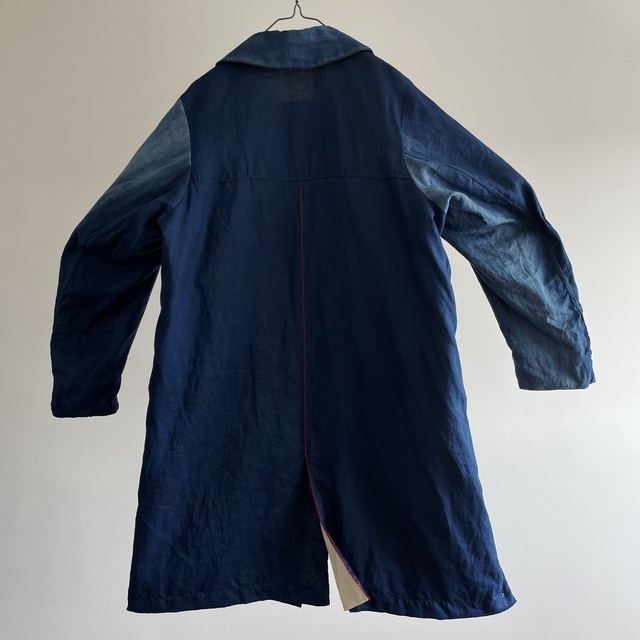
古いフランスの仕事着によく見られる、襟を1枚で作らずに強くカーブした2枚のパーツを継いだ、身頃に沿う形のフラットながらもボリュームのある襟。この衿も立体的なパターン発想が作り出したフランスならではのもの。
This is a flat yet voluminous collar that follows the body, which is often seen in old French workwear, where the collar is not made of a single piece but is made of two strongly curved parts joined together. This collar is also a uniquely French creation of a three-dimensional pattern conception.
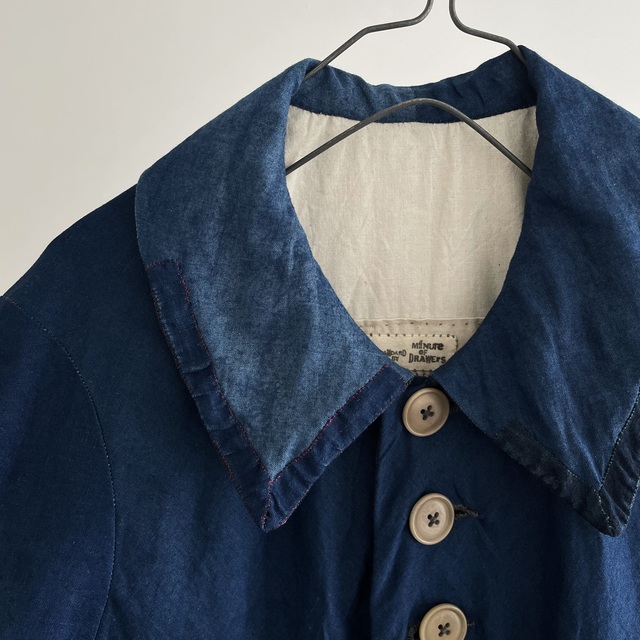
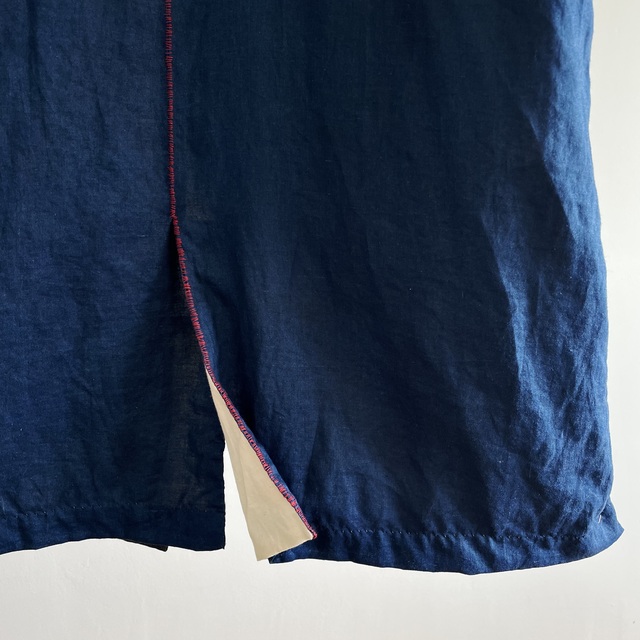
襟裏に選んだのは、india inkで染められたコードストライプのアイリッシュリネン生地です。同じコードストライプを、袖とフロントの見返しに。
We chose a corded stripe Irish linen fabric dyed with india ink for the collar lining. The same cord stripes are on the sleeves and front facing.
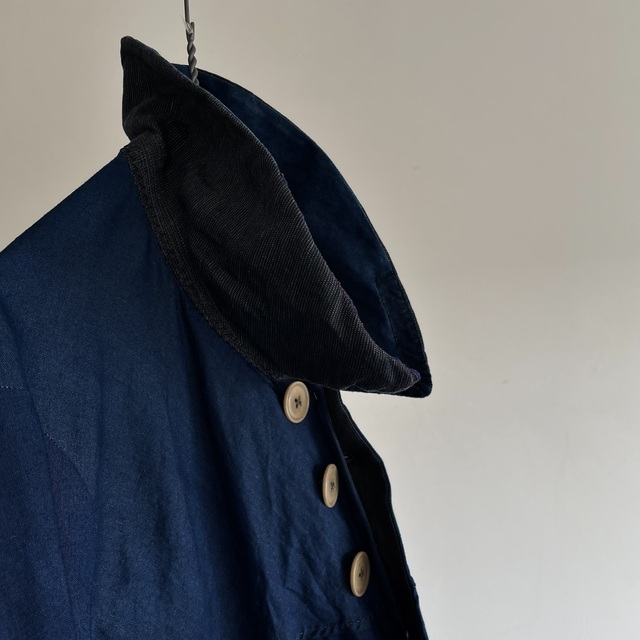
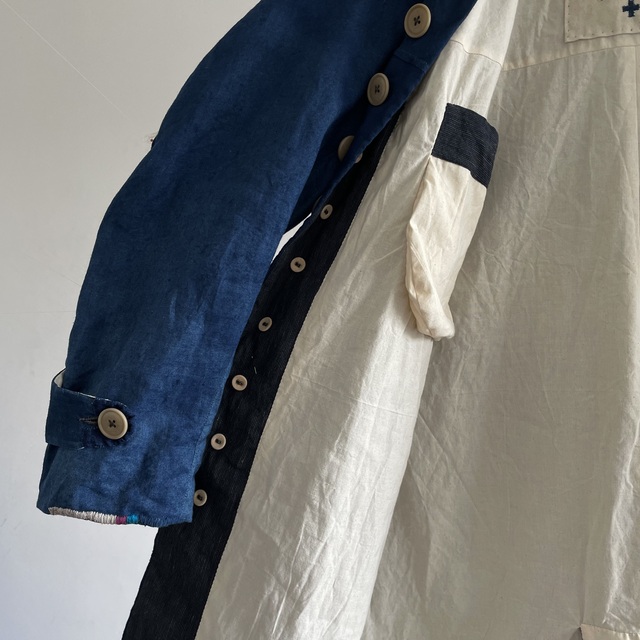
胸のヨークや腕のアウトシーム、パッチへのハンドステッチが作り出す味わい深い凹凸。
Hand stitching on the chest yoke, arm outseams, and patches creates a tasteful unevenness.
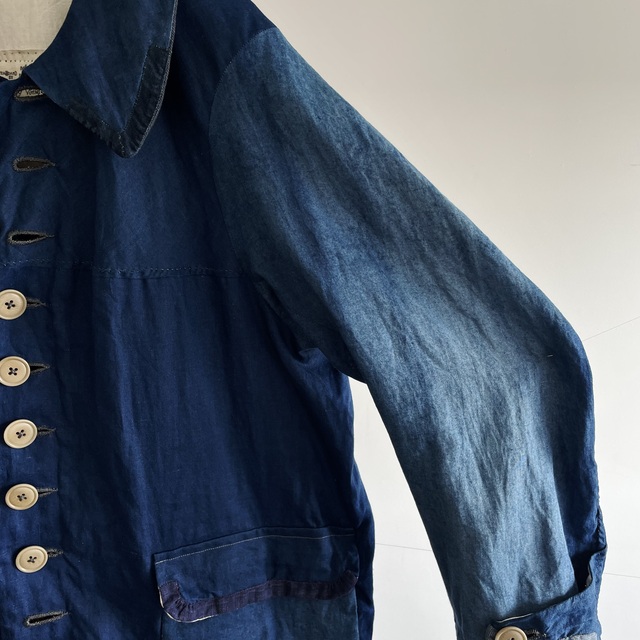
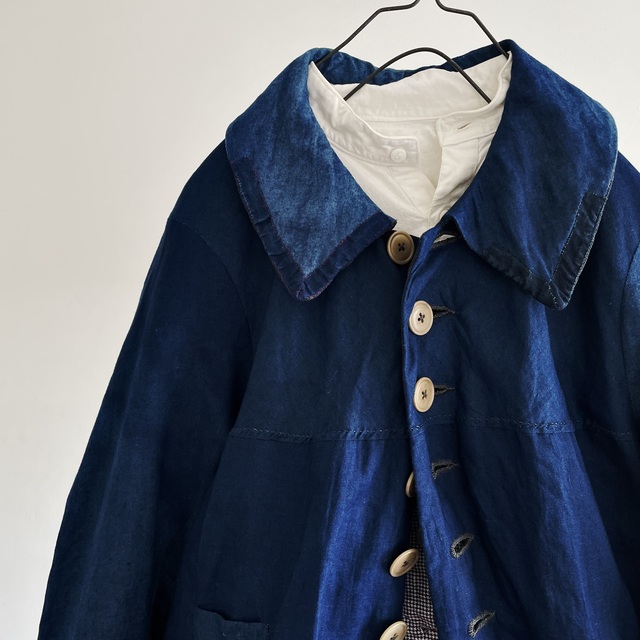
昔の生地特有の素朴な趣きを残す風合い。インディゴが少し陽に灼け、褪せた色の濃淡のグラデーションの入り混じった深い色合い。着込んで行くにつれ、さらにブルーへと変化していく楽しさ。これからの変化が、着る人の愛着の証です。
The texture retains the rustic feel characteristic of old fabrics. The indigo has been slightly scorched by the sun, and the deep hue is mixed with a gradation of faded shades of color. As the wearer wears it more and more, the more blue it becomes, the more enjoyable it becomes. The change from now on is a proof of the wearer’s attachment.
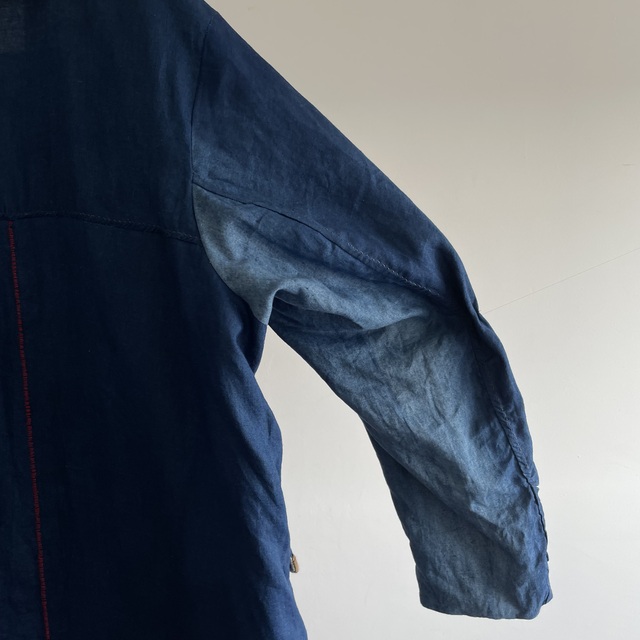
端部を浮かせて手縫いした、丸みのあるソフトなフォルムのポケット。バックセンターのシームにはほつれどめを兼ねた、ステッチを。
Pockets with a rounded, soft form, hand-stitched with floating edges. Stitching on the back center seam to prevent fraying.
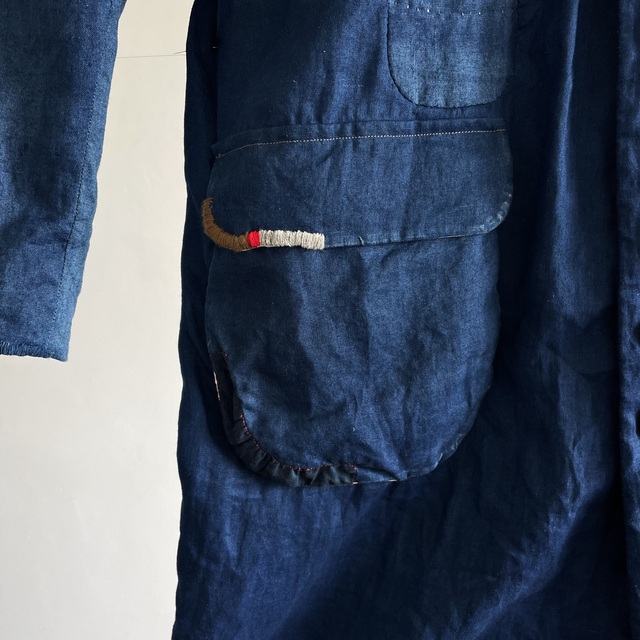
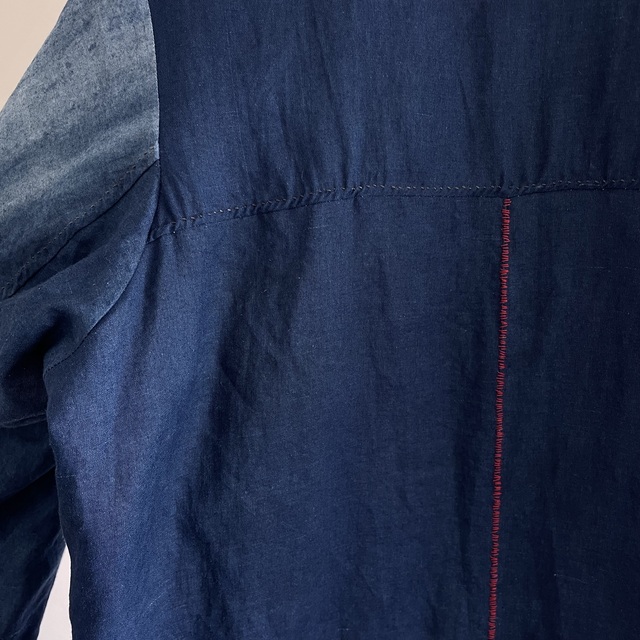
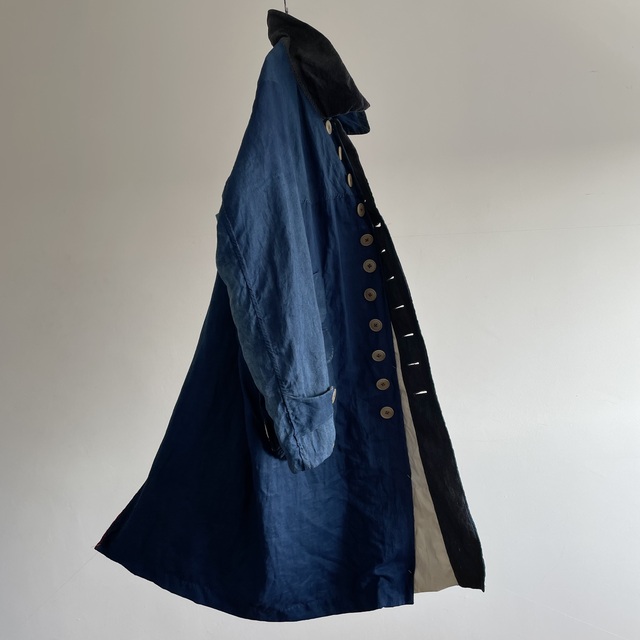
ボタンはフランスのヴィンテージのcorozo(主にエクアドルのタグワ椰子)。実の中の種子の中の胚乳部分を加工して作られた趣のあるボタン。
19世紀から1950年代にかけてのプラスティック開発以前に、滑らかな手触りと硬さ丈夫さ染色性の良さを利用して、盛んに作られていたボタンです。
The buttons are vintage French corozo (mainly tagua palms from Ecuador). These quaint buttons are made by processing the endosperm part of the seeds inside the fruit.
Before the development of plastics from the 19th century to the 1950s, these buttons were actively made to take advantage of their smooth feel, hardness, durability, and dyeability.
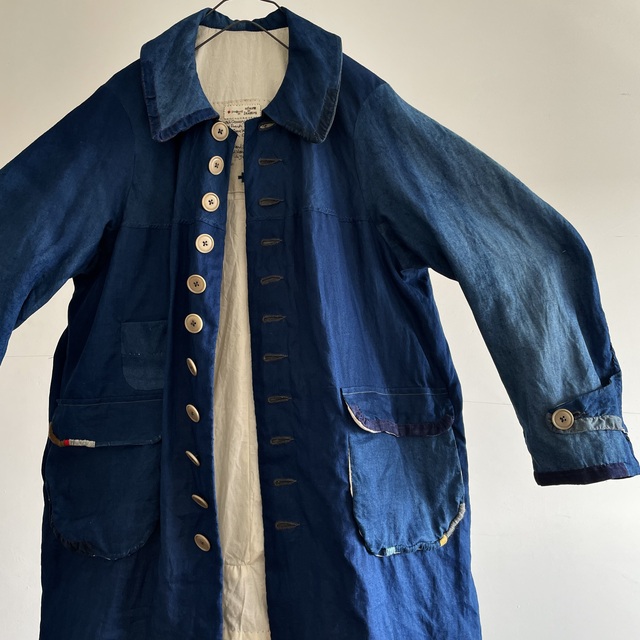
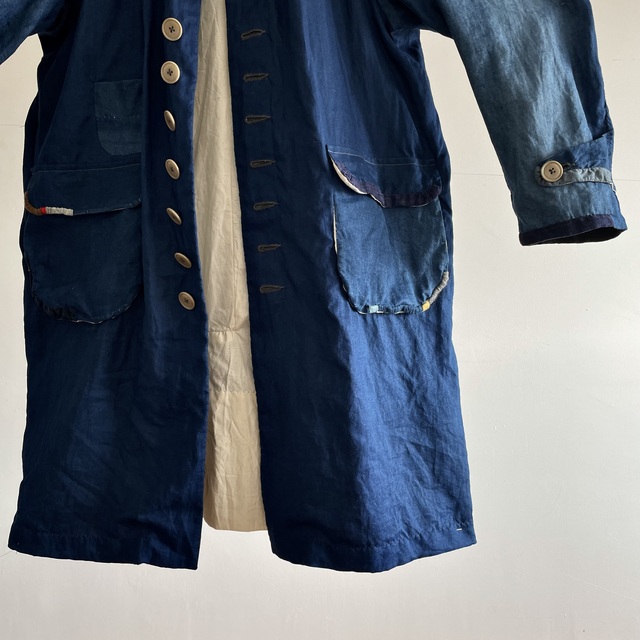
vegetable ivoryの呼び名通りの乳白色の実を削って加工される何とも言えない丸みと、乳白色のベースを染める事で生まれる優しい色合いの魅力。見た目に反してしっかりした質感と重みを兼ね備えた、味わい深さを持ったボタンです。
As the name “vegetable ivory” implies, this button has an indescribable roundness created by shaving milky white berries, and the charm of the gentle coloring produced by dyeing the milky white base. Contrary to its appearance, this button has a solid texture and weight, and has a deep sense of taste.
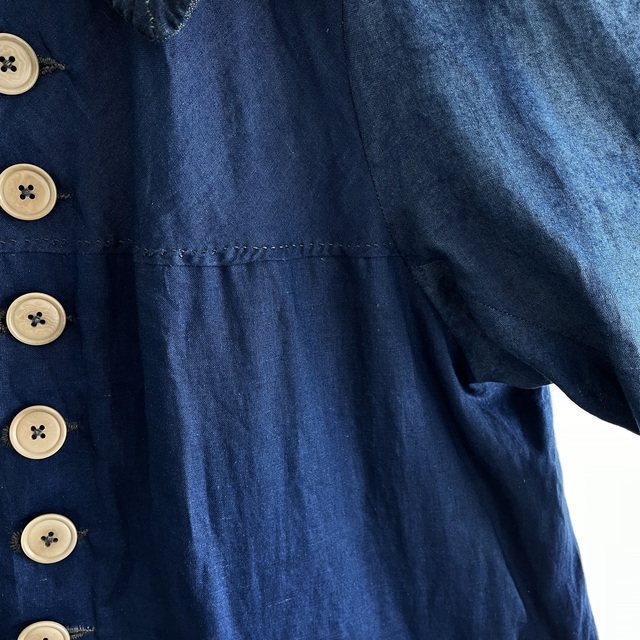
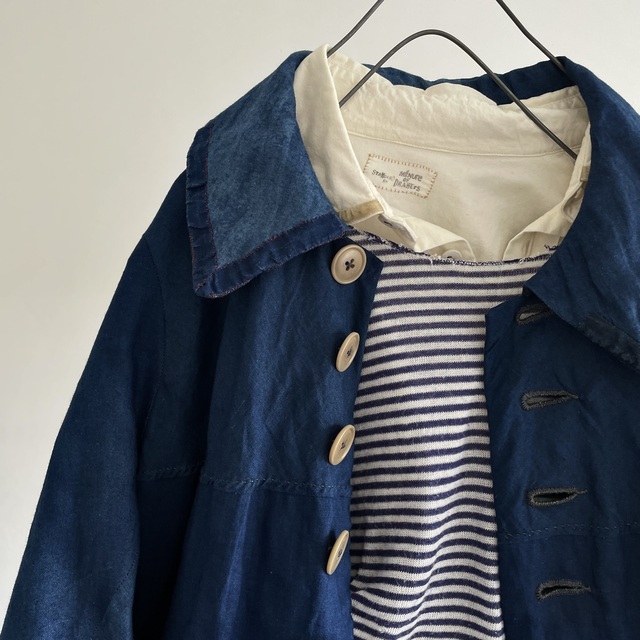
ボタンホールも全て手縫いです。しっかりとしたボリュームがありながら、柔らかな曲線を描くシルエットが貴重な生地と融合した1着です。
Buttonholes are also all hand-stitched. The silhouette is firm and voluminous, yet soft and curvy, blending with the precious fabric.
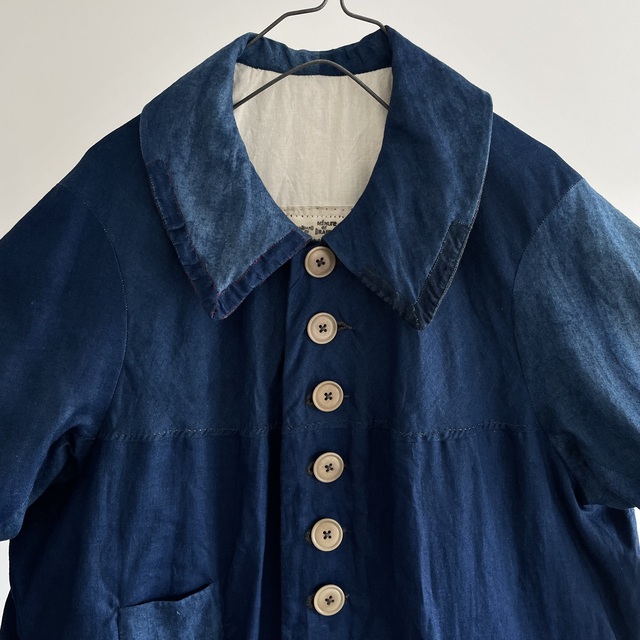
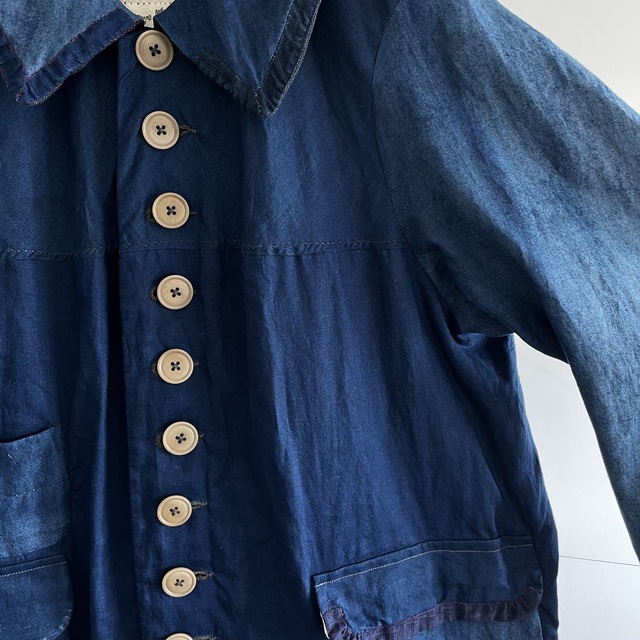
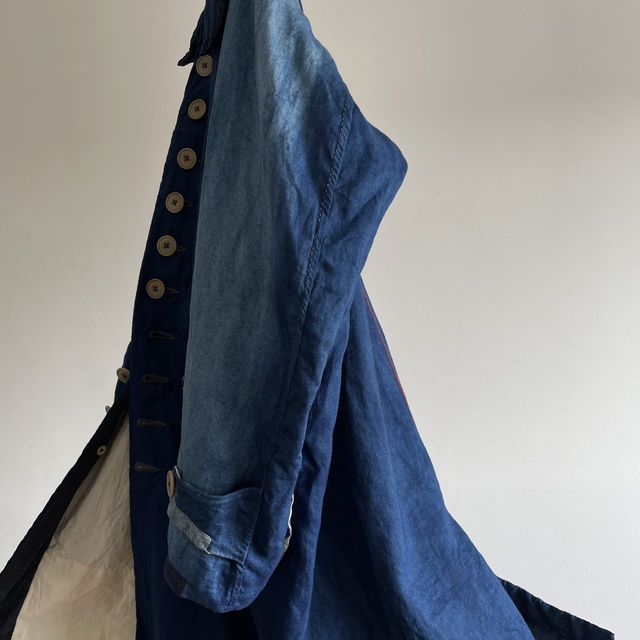
ヨーク部分の生地の方向が、肩から胸にかけてバイアス方向に変化するユニークな仕様。狭めの間隔でずらりと並べたボタンの迫力のある表情。
The yoke portion of the fabric changes direction on the bias from the shoulders to the chest, a unique specification.The powerful look of buttons arranged in a row at narrow intervals.
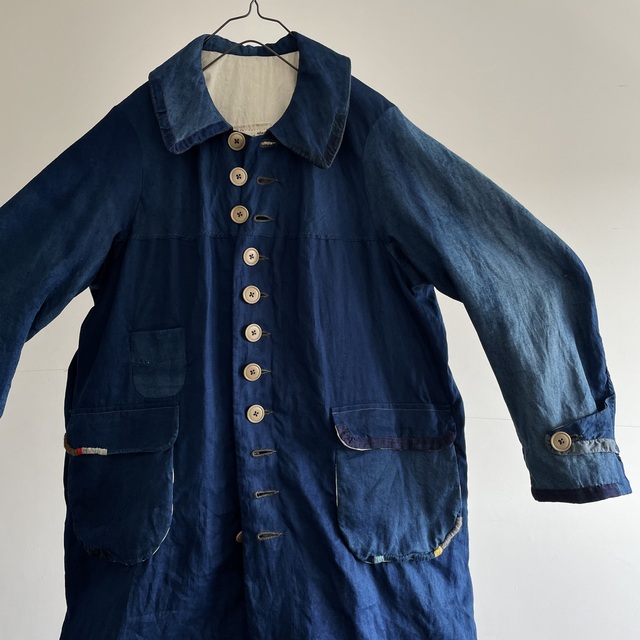
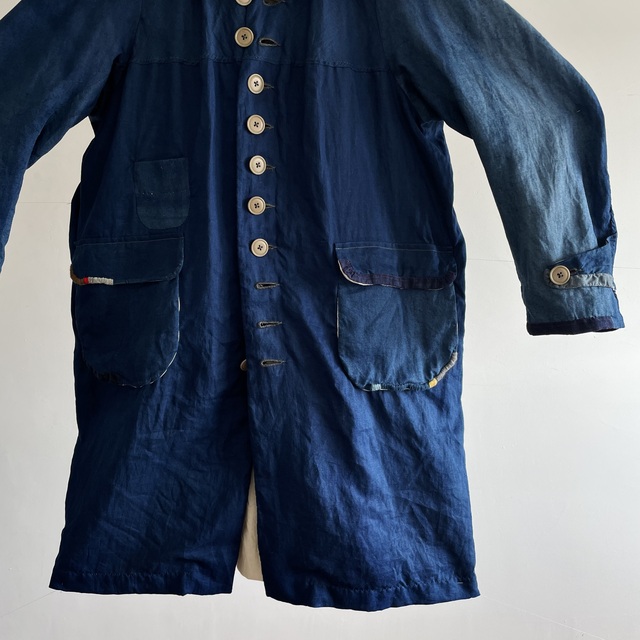
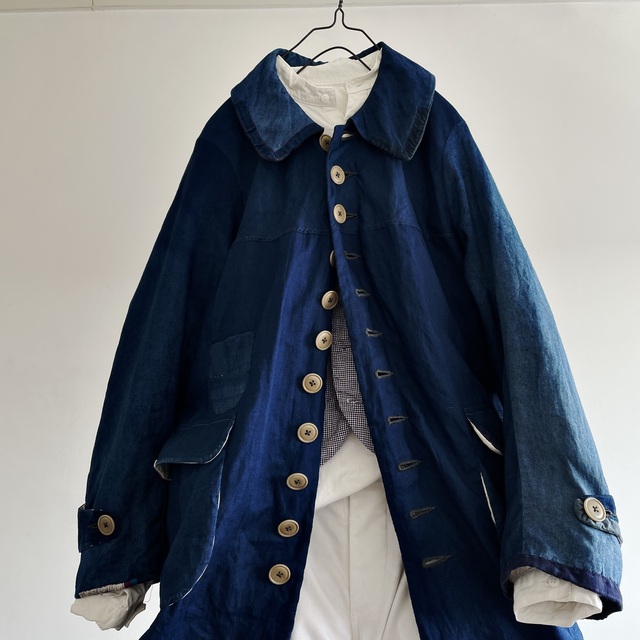
手でまつりつけたライニング。手の温もりではなくストイックさが伝わる不揃いなステッチ、縫い皺の表情や生地のコントラストが乾いた奥行きを作り出します。適度な厚みのある未晒しの素朴な風合いとしわが魅力の、インドで織られたライニングは、表地とのコントラストと清潔感を作り出してくれます。
Lining sewn by hand. The uneven stitching, which conveys stoicism rather than hand warmth, the expression of the stitching wrinkles, and the contrast of the fabrics create a dry depth. The lining, woven in India, with its rustic texture and wrinkled charm of unbleached fabric of moderate thickness, creates a contrast with the outer fabric and a sense of cleanliness.
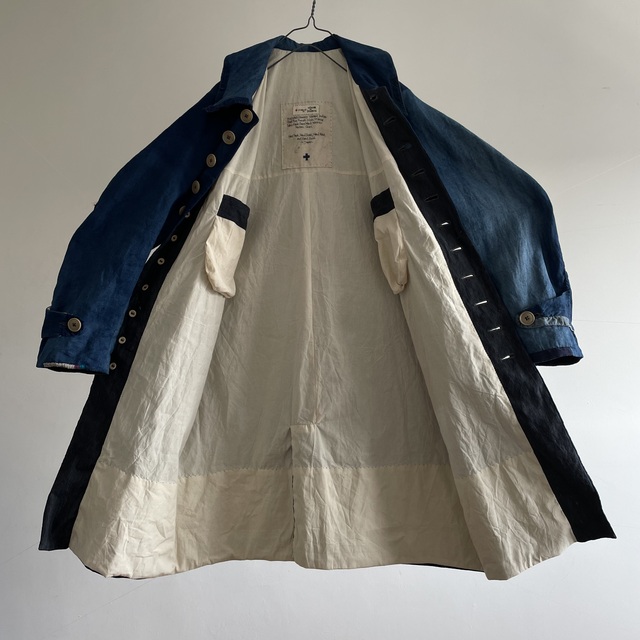
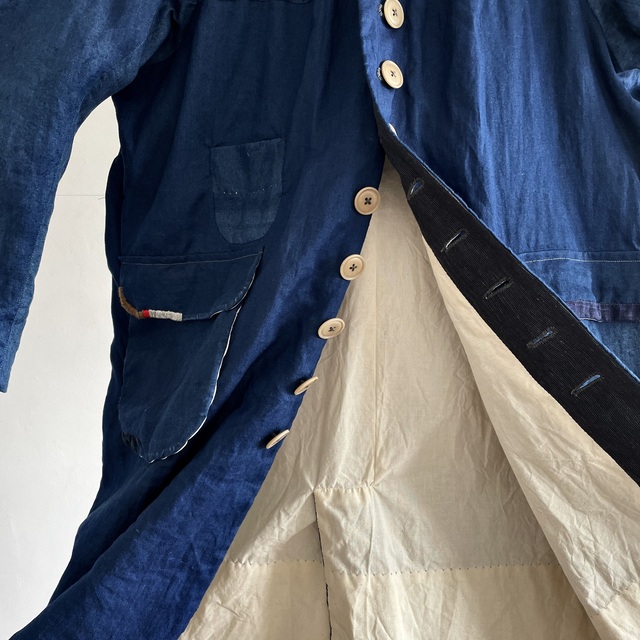
紙の上やデジタル画面の中からは、決して生み出されることのない、流行やブランドや値段の多寡に惑わされない価値観を持った方々の、その人自身を魅せる衣です。
It is a garment that fascinates people who have values that are never created on paper or digital screens, and who are not confused by trends, brands, or prices.
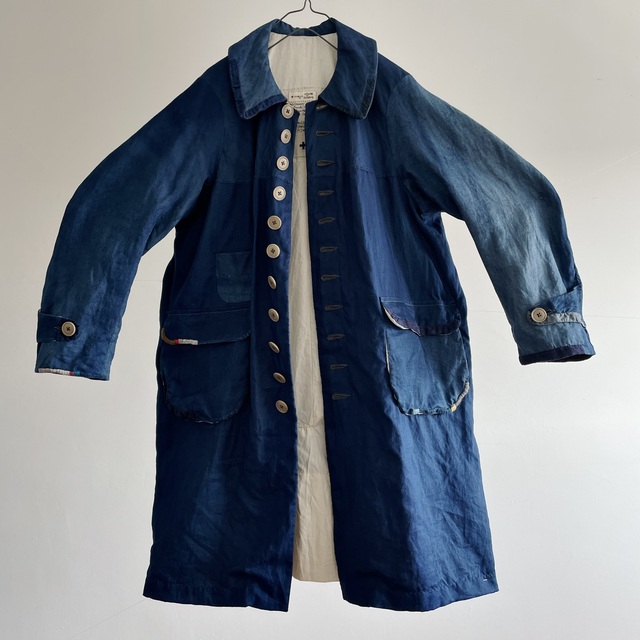
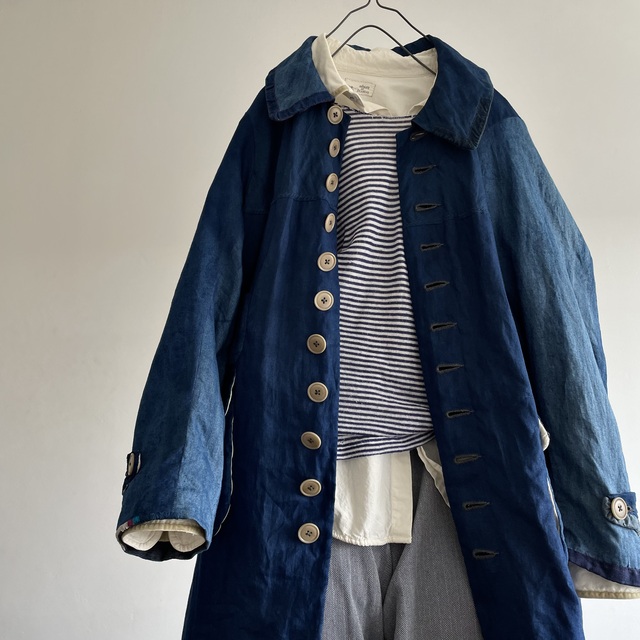
サイズ2
肩幅 = 45cm
バスト= 58cm (脇下)
袖丈 = 62cm
着丈 = 100cm
フランス/日本製
Front Fabric = Indigo Dyed Linen villette / Linen 100%
Back Fabric = Indian Rustic Cotton Broad Cloth / Cotton100%
Buttons = 1950-1960 Vintage French Corozo Button
& Antique Fabric Covered Buttons
STOREへのリンク
Mid 20th Century Vintage Indigo Dyed Pure French Linen Villette Fabric Made Chore Work Worker Coat
[STANDARD By Manure Of Drawers] SOLD

